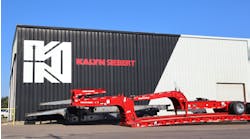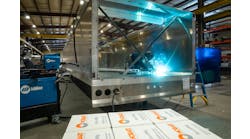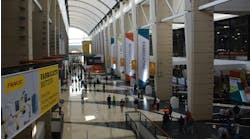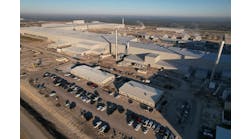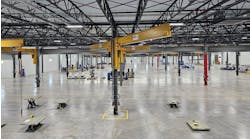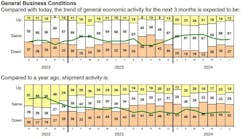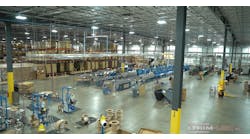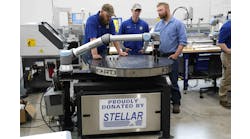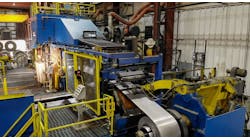AS technical services manager of AlcoTec Wire Corp, Tony Anderson has seen how the use of aluminum has transformed the manufacturing of trailers and truck bodies.
He has seen how manufacturers have utilized aluminum's desirable characteristics — its lightweight nature, high strength, versatility of both extruding and casting, and corrosion resistance — and taken advantage of improved fuel efficiency and superior recycling capabilities.
Along with that, he has seen the challenges that have to be met in welding.
“There is a change in the culture and in understanding the difference between steel and aluminum — because they are very different as far as welding's concerned,” he says. “Quite often, it's perceived to be very difficult to weld aluminum, which isn't really true. It's just different. Once you understand the difference, it's very easy to weld it — far easier than steel.”
Anderson has written a paper, “Arc Welding of Aluminum in the Truck Trailer Industry: Understanding Equipment Characteristics and the Need for Technical Training.”
He says his personal interests are directed toward the development and use of one of the more traditional methods of welding aluminum: the Gas Metal Arc Welding (GMAW), or Metal Inert Gas (MIG), process.
Some of the inherent problems associated with MIG welding of aluminum, compared to the welding of steel, are: feedability, incomplete fusion at the start of a weld, and crater or termination cracking at the ends of the weld. He says that there have been fairly recent developments with both power supplies and feeding systems used for this welding process:
- Feedability
He says this is the ability to consistently feed the spooled welding wire when MIG welding, without interruption.
“Feedability is probably the most common problem experienced when moving from MIG welding of steel to MIG welding of aluminum,” he says. “Feedability is a far more significant issue with aluminum than steel. This is primarily due to the difference between the materials' mechanical properties.
“Steel welding wire is rigged, can be fed more easily over a farther distance and can withstand far more mechanical abuse when compared to aluminum. Aluminum is softer, more susceptible to being deformed or shaved during the feeding operation, and, consequently, requires far more attention when selecting and setting up a feeding system for MIG welding.
“Feedability problems often express themselves in the forms of irregular wire feed or as burn-backs (the fusion of the welding wire to the inside of the contact tip). In order to prevent excessive problems with feedability of this nature, it is important to understand the entire feeding system and its effect on aluminum welding wire.”
He says that when starting with the spool end of the feeding system, the brake settings must be considered first. Brake setting tension, he says, is required to be backed off to a minimum. Only sufficient brake pressure, to prevent the spool from free-wheeling when stopping welding, is required.
“Electronic braking systems and electronic and mechanical combinations have been developed to provide more sensitivity within the braking system,” he says. “Inlet and outlet guides, as well as liners, which are typically made from metallic material for steel welding, must be made from a non-metallic material such as nylon to prevent abrasion and shaving of the aluminum wire.
“Drive rolls have been developed, often with U-type contours with edges that are chamfered and not sharp, that are smooth, aligned, and provide correct drive roll pressure. Excessive drive roll pressure can deform the aluminum wire and increase friction drag through the liner and contact tip. Contact tip I.D. and quality are of great importance.
“We are seeing the availability of contact tips made specifically for aluminum welding, with smooth internal bores and the absence of sharp burrs on the inlet and outlet ends of the tips which can easily shave the softer aluminum alloys. Aluminum welding wire is used in both push and pull feeder systems; however, limitations are recognized dependent on application and feeding distance. Push-pull feeder systems for aluminum have been developed and improved to help overcome feeding problems and may be used on more critical/specialized operations such as robotic and automated applications.”
- The Hot Start Feature
He says aluminum has a thermal conductivity about six times that of steel, and because of this ability to rapidly conduct heat away from the weld area, there has always been an inherent problem, particularly when starting a weld on this material. He adds that it is not uncommon to experience incomplete fusion at the start of an aluminum weld because of the material's high thermal conductivity.
“One method which can now be used to help overcome this problem, particularly on thicker sections of aluminum used in structural applications, is the use of equipment that has a hot start feature,” he says. “This feature may allow the user to program the weld starting current characteristics independently from that of the general welding current parameters, thus providing the user with the ability to start the weld with a higher current density for a predetermined period before moving to the general welding conditions for the remainder of the weld.
“This allows the use of a higher heat input at the beginning of the weld that can help to overcome the dramatic heat sink associated with this material prior to the weld area becoming heated by the welding operation. The result of this technique is to eliminate, or significantly reduce, the probability of incomplete fusion at the start of the weld and thereby improve the life expectancy of welded components subjected to high stress or fatigue loading.”
- Crater Fill Feature
He says other characteristics of aluminum that can provide welding problems are associated with its thermal expansion (which is about twice that of steel) and its shrinkage on solidification (which is 6% by volume). This can increase both distortion and weld crater size.
“One common concern when welding aluminum is crater cracking or what is sometimes called termination cracking,” he says. “When MIG welding with conventional equipment, once the trigger of the welding gun has been released, the arc is extinguished, and no additional filler metal is added to the weld pool to fill the crater. Consequently, if no further precautions are taken, a large crater will be left which will have a higher probability of cracking.
“Craters can be serious defects, and most welding standards require them to be filled and free from cracks. Run-off tabs or other methods of locating weld craters on scrap material away from the weld are not usually practical. However, if the weld pool size can be reduced before the arc is fully extinguished, the resulting crater may be very small or almost eliminated and, consequently, the weld may be free from cracks.
“In the past, a number of welding techniques have been used in an attempt to reduce this termination problem. Reversing the direction of travel at the end of a weld, increasing travel speed to reduce crater size, and providing suitable build-up and remolding the crater area flush with the weld surface by mechanical means are some of the methods which have been used. These methods are often difficult to control, require specialized training, and are not always successful in their objective.
“More recently, welding equipment has been developed for aluminum welding which has a built-in crater fill feature. This feature is designed to terminate the weld in a gradual manner by decreasing the welding current over a predetermined period as the weld is completed. This feature may be adjustable to enable the user to select the most favorable termination conditions and thereby prevent a crater from forming at the weld termination. Tests have shown this crater fill feature to be extremely user friendly and very effective in eliminating the crater cracking problem.”
Anderson says that even though the increased use of aluminum welding has promoted a demand within the industry for technically competent personnel, there remains a shortage of experienced welding engineers, technicians, inspectors, supervisors, and welders because aluminum welding has traditionally made up such a small part of the overall welding industry.
As part of his role on the Technical Advisory Board at Ferris State University — which produces the highest number of welding engineers of any college in the US — Anderson has tried to help develop a curriculum that has more emphasis on aluminum. His company also conducts four-day Aluminum Welding Technology programs at various plants that are moving from steel to aluminum.
